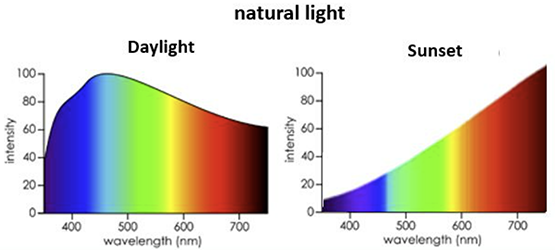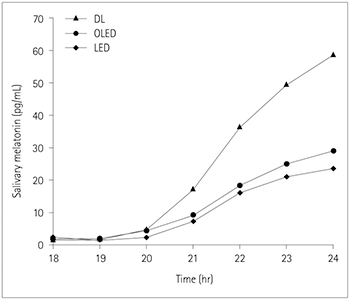A few months ago, my brother asked me about wearing blue light blocking glasses in the evening to help with sleep. And what I’ve realized is that unless I’ve taken the time to research and post about a topic on the myHealthSciences website, I’m not always sure of the answer. Sure, I’ve heard all the advertised benefits of blue blockers for sleep, eye fatigue, and macular health but what does the research show? Should you wear blue light blockers every night before bed to improve sleep quality? And even if you should, what’s my gold standard alternative that’s kept me from making the purchase? Let’s get into it!
How Does Blue Light Affect Sleep?
Previously, I’ve talked about morning light exposure in a post called A Morning Routine Must. In that post, I explained how exposure to early morning outdoor light helps set your circadian rhythm, halt melatonin production for the day which causes sleepiness, and jumpstarts cortisol production for the day which leads to alertness [1]. It’s one of the healthier habits you can get into doing each morning. But what makes morning outdoor light so effective is that it’s predominantly blue light entering your eyes. Whereas in the evening as the sun sets, that blue light dissipates, and the warm red light surges [2]. And this red light has much less of an effect on halting your melatonin production.

It’s why using warmer, redder lights in the evening can be more beneficial than cooler, bluer lights in preparing for sleep. In one study, they measured subjects evening melatonin production in various controlled environments. One of the environments was lit with organic LED lights and the other in typical LED lights. Organic LED’s tend to be slightly warmer than typical LED’s so it was theorized that exposure to organic LED’s would allow for more melatonin production in the subjects. And that’s exactly what they found with around a 25% increase in melatonin production from using only slightly warmer OLEDs vs LEDs [3].

Another study found that the strongest melatonin suppressing light occurs in the short-wavelength portion of the spectrum between 446 and 477 nm that appears blue [4]. Whereas further analysis of 15 studies indicated that the maximum melatonin-suppressing effect was achieved at the shortest wavelengths at 424 nm [5]. To be safe, I think we can say avoiding light within the 420 to 480 nm range in the evening is best for sleep preparation.

Do Blue Blockers Actually Work?
So, do blue light blocking glasses work? From all the research I could find, there’s convincing evidence that they help. In a randomized, controlled trial, blue light blocking glasses were shown to increase total sleep time, improve sleep quality, and decrease time to fall asleep [6]. In almost all measures, limiting blue light exposure in the evenings with these glasses appears to improve sleep. This study’s conclusion appears to sum up the blue blocker’s the best: “Amber lenses represent a safe, affordable, and easily implemented therapeutic intervention.”
And if you’re thinking about buying a pair now, I’ll just note that the amber tinted lenses block a wider spectrum of blue light compared to clear lenses which are marketed as more “normal looking.” So ideally, you should look for lenses that block that 420 to 480 nm light spectrum for optimal results and only wear them when the sun sets in the evening. I should also note that I couldn’t find a lot of evidence around blue blockers helping with eye fatigue and even less evidence around blue blockers for macular health [7]. Therefore, I wouldn’t recommend blocking blue light for most of the day, as earlier I mentioned how blue light can be very healthy at the right time.
The Gold Standard Alternative
With all that being said, why don’t I wear blue blockers? Well, what might be more important than blocking blue light in the evening is blocking bright light altogether no matter the color spectrum. Light intensity or brightness generates a dose dependent response to our melatonin production. The brighter the light, the more melatonin suppression [8]. Remember that study I mentioned earlier comparing organic LED vs LED regarding melatonin suppression? What I didn’t mention was that there was a third environment that was lit with dim light. And the dim light group had double the salivary melatonin levels of the OLED group. Double!

Another study compared the use of an iPad for reading just before bed compared to a paper book. Not only does the paper book not produce blue light, but it reflects little total light. Participants reading off an iPad took longer to fall asleep and had reduced evening sleepiness, reduced melatonin secretion, later timing of their circadian clock, and reduced next-morning alertness than when reading a printed book [9]. So, here are the five things I do instead of wearing blue light blocking glasses which I think are the gold standard alternative:
And what’s cool about most of these tips is that they’re automatic. The lights, the screens, I’ve set them all up once on a schedule and I never have to think about it again. Talk about that melatonin return on investment.
Final Thoughts
We’ve all seen the advertised benefits of blue light blocking glasses. And while I couldn’t find much evidence for eye fatigue or macular health, blue blockers do appear to be a cheap, easy, and effective solution for sleep. By limiting blue light within the 420 to 480 nm range, it should help you fall asleep quicker, stay asleep longer, and wake up less throughout the night. But if you’re crazy like me and want to live the healthiest life possible, I’d suggest limiting technology use in the evenings altogether. And if you have the time and money, invest in smart bulbs that automatically adjust their brightness and temperature as the day progresses to better align with natural light. And maybe have a pair of blue light glasses available for when these ideal situations aren’t possible. Because to me, that sounds like a life that’s healthier and happier.
Want a weekly update on the 3 most important things I’ve read, watched, and listened to within the past week?
Watch a YouTube Video Summarizing the Post

Hey, I am Brandon Zerbe
Welcome to myHealthSciences! My goal has always been to increase quality-of-life with healthy habits that are sustainable, efficient, and effective. I do this by covering topics like Fitness, Nutrition, Sleep, Cognition, Finance and Minimalism. You can read more about me here.
Sources:
- [1] A Randomized, Double-Blind, Placebo-Controlled Trial of Blue Wavelength Light Exposure on Sleep and Recovery of Brain Structure, Function, And Cognition Following Mild Traumatic Brain Injury
- [2] Natural Light versus Artificial Light
- [3] Effects of Evening Exposure to Light from Organic Light-Emitting Diodes on Melatonin and Sleep
- [4] Blue Light from Light-Emitting Diodes Elicits a Dose-Dependent Suppression of Melatonin in Humans
- [5] Systematic Review of Light Exposure Impact on Human Circadian Rhythm
- [6] Blocking Nocturnal Blue Light for Insomnia: A Randomized Controlled Trial
- [7] The Effect of Blue-Light Blocking Spectacle Lenses on Visual Performance, Macular Health and the Sleep-Wake Cycle: A Systematic Review of the Literature
- [8] Quantal Melatonin Suppression by Exposure to Low Intensity Light in Man
- [9] Evening Use of Light-Emitting eReaders Negatively Affects Sleep, Circadian Timing, And Next-Morning Alertness
